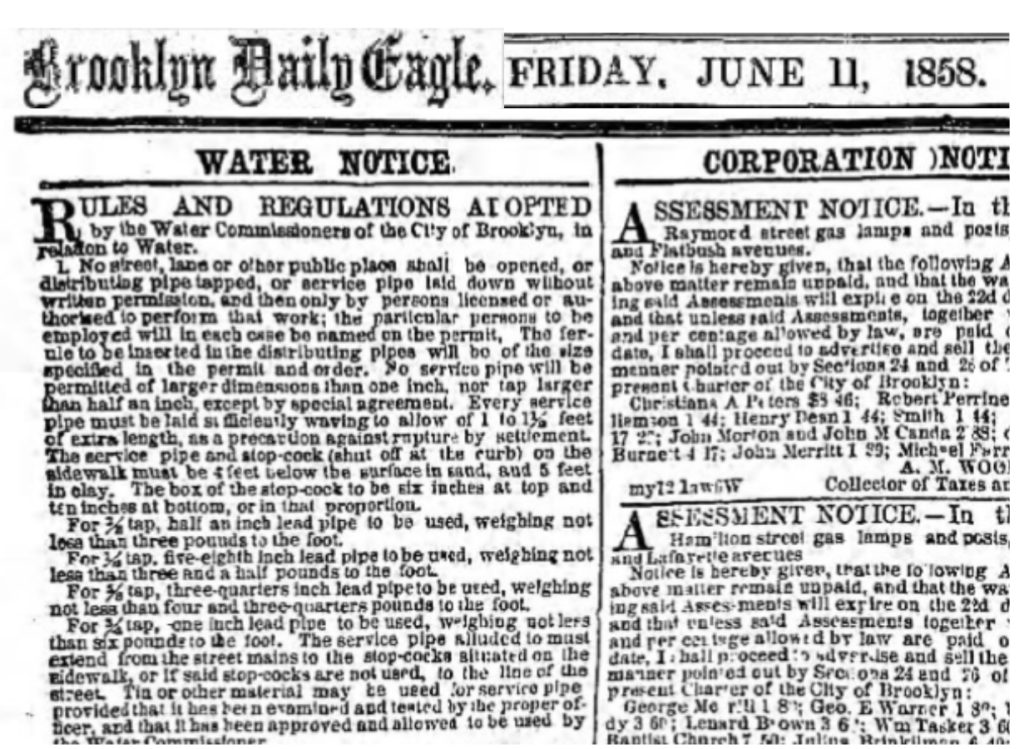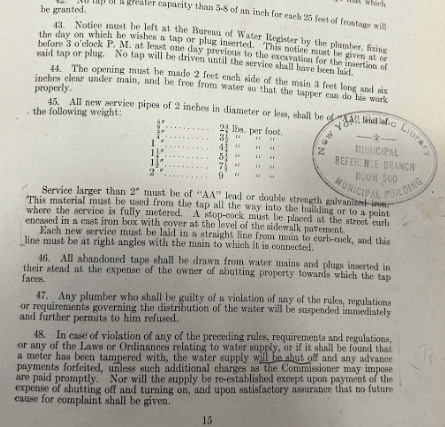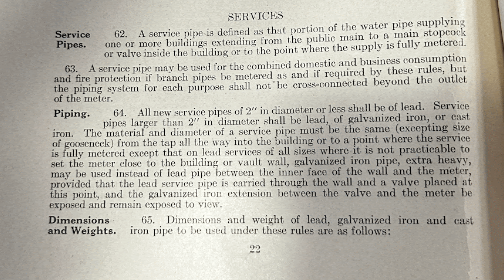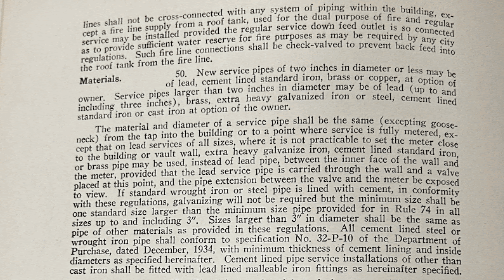A Look Back in Time: Why NYC Has So Many Lead Pipes
| August 22, 2024
Overview
New York City, like many cities around the country, is preparing to replace lead service lines that deliver drinking water to their constituents, an initiative proposed by the federal Environmental Protection Agency in their revisions to the 1991 Lead and Copper Rule. Understanding the history of how these lead pipes got here in the first place is critical as the New York City Council contemplates a program to remove all lead service lines.
Background
A drinking water service line is the pipe that delivers water from the water main in the middle of a street to a building. Service lines made of lead are a serious public health concern as lead can get into the water when a lead pipe corrodes and according to the Centers for Disease Control, there is no safe level of lead exposure. Lead exposure can cause serious negative health and behavioral problems, especially in children. Even small amounts of lead can result in lasting damage to the developing brains and nervous systems of infants and young children. This exposure can lower a child’s ability to think clearly, lead to behavioral issues, and make it harder for them to focus and learn in school. It can also cause cardiovascular issues in adults.
In New York City, lead service lines were permitted to be used until 1961.These lead service lines were typically manufactured in diameters of two inches or less and are typically found in buildings with fewer than six units.The legacy of this policy is that there are at least 130,000 known lead pipes all across New York City and possibly tens of thousands more that are possibly lead according to the latest inventory provided by the NYC Department of Environmental Protection (DEP), the water supplier for the city.
Findings
During the summer of 2024, NYC lead in drinking water researchers Niki Leshgold, Raquel Mack, Elie Weitzman, Annika Lambert, and Harlowe Dunn took a look back at the history of city policies concerning the use of lead service lines. What they discovered was that as far back as 1858 until about 1936, the city not only permitted the use of lead pipes, but at times encouraged or specifically required it.
Here is a summary of their findings:
- In 1858, the Brooklyn Daily Eagle released a “Water Notice” containing rules and regulations adopted from the Water Commissioners of the City of Brooklyn, which states lead pipes are to be used for certain size service pipes.
- For taps ranging from 3/8 to 3/4 of an inch, it was required that “lead pipe be used”
- “Tin or other material provided that it has been examined and tested by the proper officer and that it has been approved and allowed to be used by the Water Commissioner.”

The New York Department of Water, Supply, Gas and Electricity (currently known as the NYC DEP) issued regulations for new water service lines, calling for the use of lead pipes multiple times over the course of the 20th century.
- The 1911 service code:
- “All new service pipes of 2 inches in diameter or less shall be of ‘AA’ lead.”
- Service larger than 2” must be of ‘AA lead’ or double strength galvanized iron.”

- The 1923 service code:
- “All new service pipes of 2 inches in diameter or less shall be of lead.”
- “Service larger than 2” must be of lead, of galvanized iron, or cast iron.”
- “…on lead services of all sizes where it is not practicable to set the meter close to the building, or vault wall, galvanized iron pipe, extra heavy, may be used instead of lead pipe…provided that the lead service pipe is carried through the wall…”

- The 1936 service code:
- “New service pipes of two inches in diameter or less may be of lead, cement-lined standard iron, brass, or copper, at the option of the owner.”

Conclusion
There are public health risks associated with lead exposure and for at least 103 years New York City permitted, encouraged, and at times even required the use of lead pipes. Therefore, shouldn’t New York City have, at the very least, a moral obligation to take fiscal and logistical responsibility for the replacement of all lead pipes? Unfortunately, NYC Council Bill Intro 942-2024 which was introduced in June 2024, would require property owners to take on the task and expense of replacing all of their lead pipes within the next ten years, costing each owner $10,000 to $15,000 of dollars. NYLCV and its allies are advising the Council to change course, urging that the city should take on this burden as the ubiquitous presence of lead pipes was created by past city policies.
Stay tuned for more information on this important topic in the coming months.
< Back to Citizen’s Toolkit









